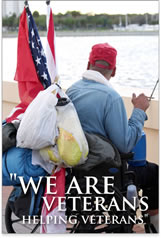Who are homeless veterans?
 The US Department of Veterans Affairs VA states that the nations homeless veterans are predominantly male, with roughly 8% being female. The majority are single; live in urban areas; and suffer from mental illness, alcohol and\or substance abuse, or co–occurring disorders. About 13% of the adult homeless population are veterans.
The US Department of Veterans Affairs VA states that the nations homeless veterans are predominantly male, with roughly 8% being female. The majority are single; live in urban areas; and suffer from mental illness, alcohol and\or substance abuse, or co–occurring disorders. About 13% of the adult homeless population are veterans.
Roughly 40% of all homeless veterans are African-American or Hispanic, despite only accounting for 10.4% and 3.4% of the US veterans population, respectively.
Homeless veterans are younger on average than the total veterans population. Approximately 9% are between the ages of 18 and 30, and 41% are between the ages of 31 and 50. Conversely, only 5% of all veterans are between the ages of 18 and 30, and less than 23% are between 31 and 50.
America's homeless veterans have served in World War II, the Korean War, Cold War, Vietnam War, Grenada, Panama, Lebanon, Persian Gulf war, Afghanistan and Iraq OEF\OIF, and the military's anti-drug efforts in South America. Nearly half of the homeless veterans served during the Vietnam era. Two-thirds served our country for at least three years and one-third were stationed in war zones.
Alarmingly, approximately 1.4 million additional veterans are considered at-risk of homelessness due to poverty, lack of support networks, and dismal living conditions in overcrowded or sub standard housing.
How many homeless veterans are there?
Because of the transient nature of homeless veterans, it's difficult to obtain perfect data or precisely pinpoint the number; however, estimates are that 79,309 veterans are homeless on any given night. Over the course of a year, nearly twice that number have experienced homelessness. While only 7% of the general population can claim veteran status, nearly 13% of the homeless adult population are veterans.
Approximately 12,700 veterans of Operation Enduring Freedom (OEF), Operation Iraqi Freedom (OIF), and Operation New Dawn be (OND) were homeless in 2010. The number of young homeless veterans is increasing, but only constitutes 8.8% of the overall homeless veterans population.
Why are Veterans Homeless?
The causes of homelessness are complex: extreme shortages of affordable housing, livable income that provides financial access to healthcare (along with physical challenges, a large number of displaced and at-risk veterans live with lingering effects of post-traumatic stress disorder (PTSD) and substance abuse), lack of family support, and difficulty cultivating social support networks. Additionally, military occupations and training are not always transferable to the civilian workforce which places many veterans at a disadvantage when competing for employment.
The top priorities for homeless veterans are secure, safe, clean housing along with a supportive environment free of drugs and alcohol.
Doesn't the Department of Veterans Affairs take care of homeless veterans?
To a certain extent, yes. The Department of Veterans' Affairs does help homeless veterans. Each year, specialized programs within the VA provide healthcare to almost 150,000 homeless veterans and other services to more than 112,000 veterans. Additionally, more than 40,000 homeless veterans receive compensation or pension benefits each month.
Since 1987, the VA's programs for homeless veterans have emphasized collaboration with community-based service providers to help expand the outreach of services to more veterans in crisis. The VA, using its own resources or in partnership with others, has secured nearly 15,000 residential rehabilitative and transitional beds and more than 30,000 permanent beds for homeless veterans throughout the nation. These partnerships are credited with reducing the number of homeless veterans by 70% since 2005.
What services do veterans need?
Veterans need a coordinated effort to provide:
- secure housing
- nutritional meals
- basic physical health care
- substance abuse care with aftercare
- mental health counseling
- personal development and empowerment
- employment assistance and training
The most effective programs for homeless and at risk veterans are community–based, nonprofits, veterans helping veterans groups, like VAF. Programs that seem to work best feature transitional housing with the camaraderie of living in a structured, substance free environment with fellow veterans who are succeeding at bettering themselves.
Government money, while important is limited, and available services are often at capacity. It is critical, therefore, that community groups reach out to help provide the support, resources and opportunities that most Americans take for granted: housing, employment and health care. Veterans who participate in collaborative programs are afforded more services and have a higher chances to becoming taxpaying, productive citizens again.
DEFINITIONS, DEMOGRAPHICS AND ESTIMATED NUMBERS
The United States code contains the official federal designation of homelessness, which is commonly used because it controls federal funding streams. In title 42, chapter 119, sub chapter one, homelessness is defined as;
11302. General definition of homeless individual
For purposes of this chapter, the term "homeless" or "homeless individual" or "homeless person" includes-
1. an individual who lacks a fixed, regular, and adequate nighttime residence; and
2. an individual who has primary residence that is
- a supervised publicly or privately operated shelter designed to provide temporary living accommodations (including welfare hotels, congregate shelters, and transitional housing for the mentally ill);
- an institution that provides a temporary residence for individuals intended to be institutionalized; or
- a public or private place not designed for, or ordinarily used as, a regular sleeping accommodation for human beings.
- 13% of homeless adult population are veterans
- 20% of male homeless population are veterans
- 68% reside in principle cities
- 32% reside in suburban\rural areas
- 51% of individual homeless veterans have disabilities
- 50% have serious mental issues
- 70% have substance abuse problems
- 51% are white males, compared to 38% of non-veterans
- 50% are age 51 or older, compared to 19% non- veterans
